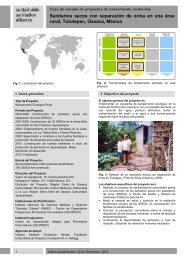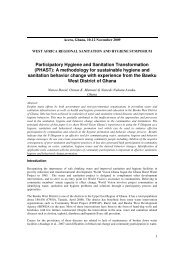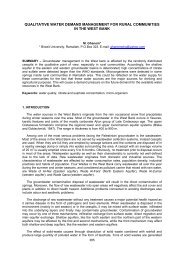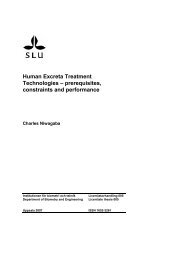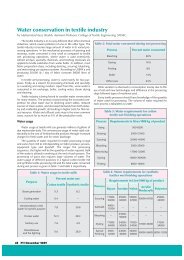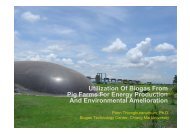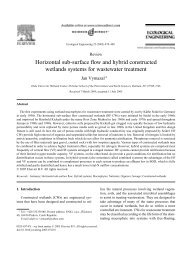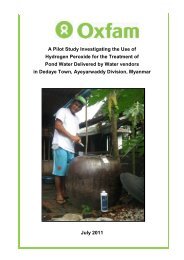Fertigation: Optimizing the Utilization of Water and Nutrients - SSWM
Fertigation: Optimizing the Utilization of Water and Nutrients - SSWM
Fertigation: Optimizing the Utilization of Water and Nutrients - SSWM
Create successful ePaper yourself
Turn your PDF publications into a flip-book with our unique Google optimized e-Paper software.
The worldwide irrigated areas are presented as percentages <strong>of</strong> <strong>the</strong> total l<strong>and</strong> area<br />
in a map produced by <strong>the</strong> FAO (Siebert et al., 2005). The most heavily irrigated<br />
areas are in China <strong>and</strong> India, <strong>the</strong> world’s most populated countries. Drip<br />
irrigation <strong>of</strong> closely spaced row-‐planted crops such as wheat <strong>and</strong> rice is not<br />
economic, <strong>the</strong>refore, <strong>the</strong> sprinkler or flood systems are common. Today, leisure<br />
industries <strong>and</strong> facilities such as football pitches, golf courses <strong>and</strong> tennis courts<br />
have adopted subsurface trickle irrigation systems to extend <strong>the</strong>ir availability,<br />
albeit at high costs.<br />
“<strong>Fertigation</strong>” – “fertilization” plus “irrigation” – was applied to tomatoes grown<br />
on s<strong>and</strong> dunes in a field experiment performed in 1969 (Sagiv <strong>and</strong> Kafkafi.,<br />
1974), <strong>and</strong> Goldberg et al. (1971) reported <strong>the</strong> distribution <strong>of</strong> minerals <strong>and</strong><br />
nutrients from a point source <strong>of</strong> irrigation to roots. <strong>Fertigation</strong> has now spread<br />
all over <strong>the</strong> world.<br />
Benefits <strong>of</strong> drip irrigation <strong>and</strong> fertigation<br />
Technological turning points in drip irrigation development in Israel<br />
1960<br />
1965<br />
1976<br />
1980<br />
1983<br />
1990<br />
2000<br />
Use <strong>of</strong> a perforated rubber tube for subsurface irrigation (Blass, 1964).<br />
First plastic linear-‐flow dripper produced by Netafim was used in <strong>the</strong><br />
field in <strong>the</strong> sou<strong>the</strong>rn Negev. Precipitated chemicals blocked <strong>the</strong> flow,<br />
which resulted in <strong>the</strong> development <strong>of</strong> <strong>the</strong> turbulent flow dripper (1970).<br />
Pressure-‐regulated dripper is developed, allowing constant flow in spite<br />
<strong>of</strong> pressure fluctuations <strong>of</strong> 3.5 atmospheres. It provides regulated flow<br />
<strong>and</strong> self cleaning.<br />
First use <strong>of</strong> drip irrigation in large areas <strong>of</strong> corn <strong>and</strong> cotton fields.<br />
Increases yields by ~25-‐35%.<br />
Enclosure <strong>of</strong> <strong>the</strong> dripper within a smooth tube is developed, to enable<br />
mechanical rolling <strong>and</strong> spreading (multi-‐season pressure regulation).<br />
Special stick-‐in drippers developed for greenhouse use.<br />
New family <strong>of</strong> integral drippers, especially suited for subsurface drip<br />
irrigation.<br />
Expected benefits from fertigation<br />
1.<br />
2.<br />
3.<br />
4.<br />
Improved nutrient availability.<br />
Enhanced plant nutrient uptake.<br />
Reduced fertilizer application rates <strong>and</strong> water requirements.<br />
Minimized nutrients losses through leaching.<br />
9



